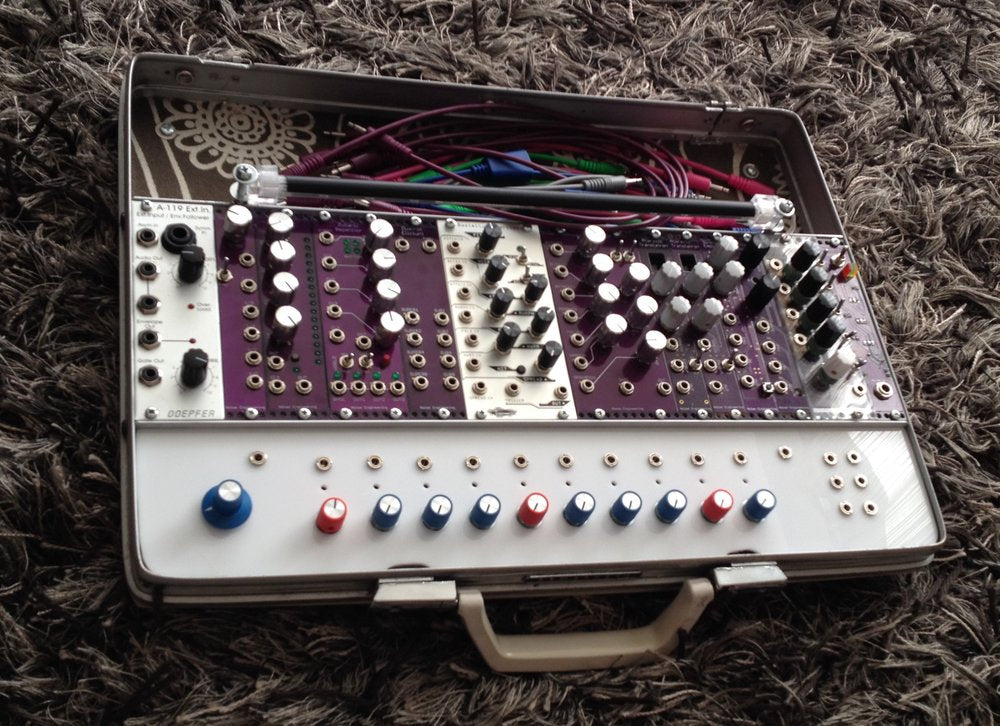Modular Cases! Guest post...and the Blog lives.
A note before we start: it's been a minute. We know. With just two of us, sometimes we get swamped and things like the blog fall by the wayside...but we're still working on more content. What do you want to know more about? Tell us!
This post is part of a series of guest-post tutorials from Noise Engineering users showing off various tips for NE modules, modular use in general, or how they integrate modular into their workflow. Have someone you think would be great to write a guest post? Have a modular tip you want to submit for us to create a video around? Please submit ideas for this occasional column here.
We talk to a lot of modular users. People interested in modular are trying to find that first case. People who have been doing modular for a while are always on the lookout for another case for their ever-expanding collection of modules.
We considered tackling this question but realized that our friend Shawn is a far better go-to for all things cases. Shawn has an impressive array of cases, but most are done on a budget, as you will see. These are the ones we were particularly interested in (and that draw the most questions everytime we stand close to him at a gig).
We asked Shawn to talk a little about his custom cases, the quest that brought him to them, and how he puts a case together. He’ll take it from here.
Like many synth freaks, for years I had longed for two synthesizers in particular that held an almost magical allure; the Buchla Music Easel and the EMS Synthi AKS. Beyond the obvious appeal of their respective unique sound palettes, there was something else incredibly alluring about these devices: their form factor. Both are like something out of a ‘60s James Bond film, being housed in portable attaché cases with colorful knobs, sliders, joysticks or touch plates.
But isn’t it just about the sound? Well, if that were the case, I suspect the current resurgence of hardware modular synthesizers wouldn’t be happening with such gusto. I think most of us spend so much time on computers for work and social life that it feels good to get away from the screen. There is something satisfying about the hands-on experience of using knobs, cables and tactile controllers when working with a modular synthesizer. And beyond that, many users will tell you that they have spent hours rearranging modules in their cases to have get the layout right and have even ordered custom knobs to swap out on their modules to get a coherent look and feel. This special allure is what Don VanVliet called “cootie appeal,” referring to the colorful children’s toy. Most anyone who has perused modular forums has come across the long threads of people showing pics of their unique and fantastic looking synth rigs. When you make an instrument your own, there is something even more satisfying about playing it; it beckons!
So back to 2010: I was getting into modular synthesis, both the Easel and the Synthi were extremely rare and very expensive (the Buchla Music Easel has since been reissued, and clones true to the original have become available. The Synthi is technically still available, but I believe the wait list is something like 10 years long and the original cases are in short supply).

So in an attempt to satisfy the desire for sleek, powerful, portable synthesizers, I took to making my own briefcase synths with modern Eurorack modules and some custom electronics.
It just so happened that the several vintage Samsonite briefcases I already had found at thrift stores were almost exactly 84hp. The average price I spent on these is about $10 apiece.I figured out that I could slightly file down rails and put right them into the cases. I added rubber feet to the bottoms and modified the lids so they can be removed. Bonus: on a stand, the handle doubles as a cable holder!
For the first one I made, I had a vision of a ribbon controller but with something I’d never seen before (or since) which is to also have discreet interval buttons that will jump up or down from the note you are holding on the ribbon to an interval set by a pot (in this case they are set by trim pots under the hood). I also wanted to have a Martenot-like pressure sensor to use on VCAs, filters, or whatever (hey, this is modular!).

The problem I had was that I did not have the electronics skill set to build the guts of such a controller. Lucky for me, I know a certain Stephen McCaul who quickly drew up a schematic for me that ended up working perfectly the first time without any modifications. [Ed. note: This was around the time Shawn also convinced Stephen to create what became the Ataraxic Translatron, our first module. So one can easily blame Shawn for all of this noise….Shawn’s early role in the company also explains the inordinate amount of non-released NE modules you’ll see in these photos. Shawn has long been an unofficial tester of almost all things NE.] [Ed. note 2: no, we don't do this as a general service...]
I took inspiration from both the EMS and Buchla worlds. I used a Choices joystick for additional control and for the main voice I used a Make Noise DPO and an Optomix for the VCO/filter. (To see my original blog post about building this first briefcase synth, go here: https://pyraphonic.wordpress.com/2012/11/11/modular-synth-briefcase-withcustom- ribbon-controller/).
The gold circle to the left of the ribbon is the pressure sensor. The black buttons drop the pitch and the red ones raise it. The DIY module to the far right has a clock and a mono-to-stereo output converter with an attenuator.

For the next case I put together I wanted something really versatile, fun and powerful. I managed to cram two rows of 84 HP in this one. Here it is below in its current incarnation. This thing is capable of a lot in a really small package. The combination of the Noise Engineering voices (Loquelic Iteritas, Sinc Iter, and Basimilus Iteritas Alter) along with the Music Thing Chord Organ and Radio Music modules offer a rich palette. Those sent through the Tiptop Audio Z-DSP with the Valhalla card is pretty fantastic and lush!

This one is particularly shallow. I had to do some creative manipulating on deeper modules like 2HP to get them to fit in this one (don’t ask!). Phillip K. Dick’s Exegesis is thicker than this case!
Most recently I put together a case for treating external sources in a rhythmic way. I have a DIY quad-vactrol module that is triggered by the Noise Engineering Numeric Repetitor. These sounds are funneled into a Tiptop Audio Z-DSP. Currently in the box are the Bug Brand Board Weevil (2009) and a prayer box I bought in Hanoi, but any sources can be easily routed through it.


One remains unfinished, but the plan is to have the DIY step sequencer along the bottom running the show.
I love how the form factor of these turned out and they look great on stands. I can live out my Kraftwerk minimalist dreams!




So has all this quelled the desire for an Easel or Synthi? Well, not entirely but building these has been super fun and rewarding. And I have those synths to thank for the inspiration to make several unique instruments of my own. These are really easy to take anywhere and you can play them in your lap. They sound fantastic and I have used them a ton for sound design work, performances and recordings. It’s always fun to see people’s reaction when I take the lid off these things...and even more fun when they hear what they are capable of!
Shawn Jimmerson is a Los Angeles based sound designer, musician and producer.
Find more about Shawn at his blog or follow him on instagram. Check him out on Spotify too!
Stay tuned to the Noise Engineering blog for more tips and tricks for modular users. And if you have questions you'd like to see here, please drop us a line.





